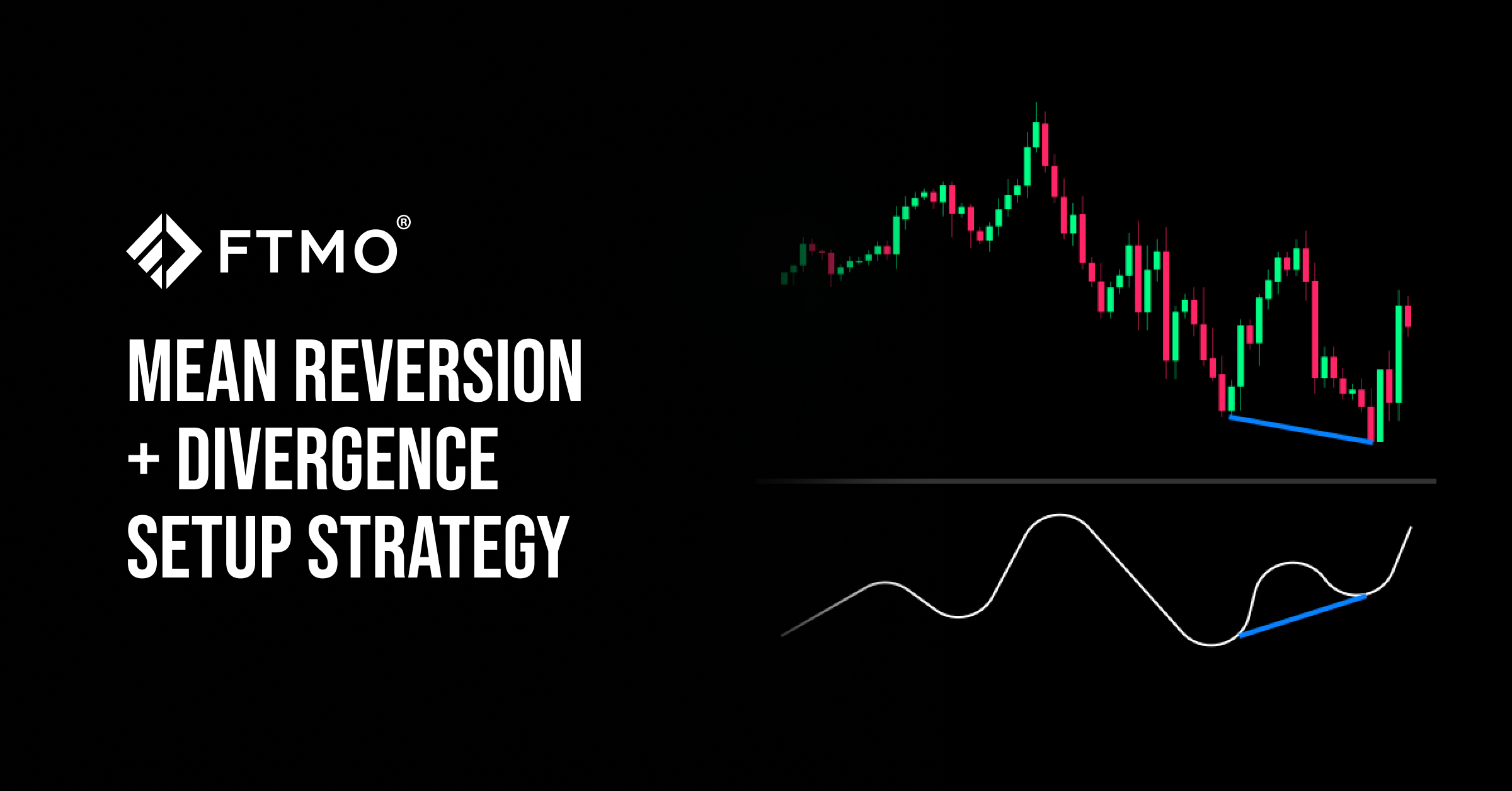
Mean Reversion + Divergence Setup Strategy
The trading strategy we will describe today focuses on trading against short-term extremes in the market, using the concept of mean reversion combined with divergence between price and indicators.
Using a combination of several well-known and widely used indicators, this strategy is ideal for traders who prefer to take quicker profits within a range-bound market or short-term trend reversals.
Strategy Description
The basic objective of the strategy is to identify extreme situations in the market when the price is too far from its average and find entry points using the divergence between price and oscillators. As mentioned, the strategy uses several indicators and a combination of them. It uses Bollinger Bands, Relative Strength Index (RSI) and Moving Average Convergence Divergence (MACD) to provide the entry signal. The Average True Range (ATR) indicator serves as a complement.
Bollinger Bands (BB)
Bollinger Bands is one of the most famous indicators marking the relative representation of the maximum and minimum prices of an instrument. It uses the standard deviation as a measure of the instrument's volatility when determining the bands and their distances. According to the author John Bollinger, volatility, which distinguishes this instrument from other pure trend indicators, is a dynamic variable that changes over time and can be used to track deviations from the average price. In our strategy, we use the basic parameters, which are SMA 20 and standard deviation 2.
Relative Strength Index (RSI)
The RSI is a momentum oscillator that measures the direction and trend dynamics of an investment instrument and determines how quickly its price has changed over a certain period. It displays in a separate chart window and its line moves (oscillates) between the values 0 and 100. The basic principle of the RSI is that if the price of an instrument rises too quickly, at some point the instrument may be considered overbought, while if the price falls quickly, it will be considered oversold. For this indicator we use a setup in which the number of periods is set to 14, the oversold level is 35 and the overbought level is 65.
Moving Average Convergence Divergence (MACD)
MACD combines the properties of a trend indicator and a momentum oscillator. It shows the relationship between two exponential moving averages for a selected instrument. In the basic setting, the MACD is calculated by subtracting the longer moving average with a period of 26 (EMA 26) from the shorter moving average with a period of 12 (EMA 12). The exponential moving average assigns more weight to the most recent prices. The signal line is then the simple moving average of the MACD indicator with period 9 (SMA9) and in our strategy we will look for divergences between price and the MACD histogram.
Average True Range (ATR)
Average True Range (ATR) indicates the average of the true ranges over a certain period, i.e. it measures the volatility of an instrument taking into account any gaps that form on the chart. In the basic setup, the number of periods is set to 14 and in our strategy we use it to measure volatility.
Rules of entry into the position.
Identification of an extreme situation:
Price should close outside the Bollinger Bands indicator.
- Closing above the upper band means that the market is probably overbought - a signal of possible selling.
- A close below the lower band means that the market is probably oversold - a signal of possible buying.
Confirmation using RSI and divergence on MACD
Oversold and Overbought on the RSI: The indicator highlights oversold condition when the price of an instrument rises quickly or overbought condition when the price drops quickly.
- Overbought (above 65) - a signal of possible selling.
- Oversold (below 35) - a signal of possible buying.
Divergence on MACD histogram: Divergence between the price of an instrument and the MACD indicator indicates that the price is making new extremes (lows or highs), but the momentum in the market is weakening and the direction of price movement may change.
- Bullish divergence occurs when the price is making lower lows, but the MACD is making higher lows - a signal of possible buying.
- A bearish divergence occurs when the price makes higher highs but the MACD is making lower highs - a signal of possible selling.
Entering the trade
Long position
- Price closes below the lower band of the Bollinger Bands.
- RSI is below 35 (oversold).
- MACD histogram shows a bullish divergence.
Entry:We open a long position when the price goes back above the lower Bollinger Bands.
Short position
- Price closes above the upper Bollinger Bands.
- RSI is above 65 (overbought).
- MACD histogram shows a bearish divergence.
Entry: We open a short position when the price goes back below the upper Bollinger Bands
Stop Loss and Take Profit
Stop Loss is set above the swing high for selling and below the swing low for buying.
Take Profit is set on the middle line of Bollinger Bands (SMA 20). An alternative is to set the Reward to Risk Ratio (RRR) at 2:1.
Filters to increase the success rate
Volatility
We only trade this strategy during periods of higher volatility, which the ATR indicator can help us monitor.
Timing
It is a good idea to avoid high-impact news that may cause a continuation of the trend instead of a reversion to the overall trend.
Trend filter
If the long-term trend is clear (EMA 200), it is good to trade mean reversion only against weak corrections (not against a strong trend).
Example of a trade
In the chart below with the price of gold (XAUUSD), we see a situation where the price is above the upper Bollinger Bands. At the same time, it has formed a new higher high, but a lower high is forming on the MACD and there is a divergence between the price chart and the MACD. The ATR (orange line in the chart window along with the RSI) is showing increased volatility and the RSI is above 65.
After the price returns below the upper Bollinger Bands, we can enter a pending order to enter a short position (light green line with an arrow). We set the SL above the last high (dark red line), TP1 can be set just below the middle line of the Bollinger Bands, which would mean RRR 1:1. Alternatively, we can target an RRR of 2:1, with TP2 above the lower Bollinger Bands line. After entering the market, the price went down and gradually reached first the TP1 level and then also the TP2 level, so the trade ended with a profit in both cases.
Advantages of the strategy
This is a quite specific strategy, where the trader must be patient enough, but for which he will be rewarded with good signals in markets where most traders fail.
- It works well in low volatility markets or in consolidations.
- Divergence increases the probability of a correct entry.
- Bollinger Bands provide visual confirmation of extremes in the market.
Disadvantages
No strategy is for all types of traders, and that is true for this strategy as well.
- The strategy does not work well in strongly trending markets.
- It requires discipline while waiting for confirmation of divergence and other signals. This in itself is not a disadvantage, but many inexperienced traders have a problem with discipline.
Conclusion
This strategy is ideal for traders looking for a systematic approach to trading short-term extremes and reversals with clearly defined rules and low implementation complexity. It requires strong discipline and patience, but as a result it can be a good tool for traders in times when markets are lacking a strong trend or there is a trend reversal that may not be obvious at first glance. Trade safely!
All information provided on this site is intended solely for educational purposes related to trading on financial markets and does not serve in any way as a specific investment recommendation, business recommendation, investment opportunity analysis or similar general recommendation regarding the trading of investment instruments. FTMO only provides services of simulated trading and educational tools for traders. The information on this site is not directed at residents in any country or jurisdiction where such distribution or use would be contrary to local laws or regulations. FTMO companies do not act as a broker and do not accept any deposits. The offered technical solution for the FTMO platforms and data feed is powered by liquidity providers.
About FTMO
FTMO has developed a two-step evaluation process to find trading talents. Upon successful completion, you may be eligible for an FTMO Rewards Account with a balance of up to $200,000 in simulated funds. How does it work?
















